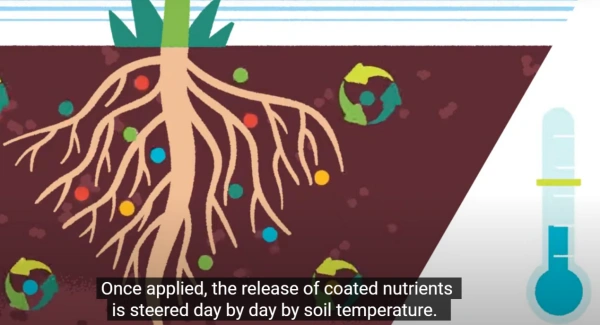Controlled Release Fertilizers (CRFs) are specialized fertilizers coated with a semipermeable membrane, designed to gradually release nutrients into the soil over time, providing a steady and predictable supply of essential nutrients to plants.These and other fertilizers are used by farmers around the world to increase yields and produce better crops. They can supply a wide range of nutrients, from the three basic macronutrients (nitrogen, phosphorus, and potassium), to a number of micronutrients that assist with plant growth.
With many farmers concerned with nutrient use efficiency and environmental impact, many have chosen to utilize controlled release fertilizers. CRFs are granular fertilizers coated with a semipermeable membrane that gradually release nutrients into the soil over a given period of time and are commonly used across agricultural production.
Studies have shown that growers can achieve higher production and higher quality using CRFs while meeting new regulations to limit nitrogen losses to the environment.
CRFs are used in all agricultural and horticultural crops across the world and the specific CRF products differ for each crop, nutrient composition, release time, and more. Understanding how to use controlled release fertilizers, controlled release vs slow-release fertilizers, the advantages of controlled release fertilizers.
How do CRFs work?
Controlled Release Fertilizers (CRFs) are granular fertilizers that are covered by a semipermeable membrane and when applied to the soil, allow moisture to penetrate it and reach the nutrient(s) inside.
The core of the controlled release fertilizers start to dissolve and day by day, at a rate influenced by soil temperature, small amounts of nutrients are released back into the rooting zone for plant uptake. This practice limits nutrient losses and offers predictable availability of nutrients (from 1-2 months, up to 16-18 months) that is aligned with the plant’s needs.
CRFs are designed to provide farmers with maximum results with minimal effort. By regulating plant nutrient levels throughout the entire growth cycle, plants have limited exposure to nutrient deficiency and are able to have more uniform growth and usually higher yields.
Controlled Release Fertilizers vs. Slow Release Fertilizers?
It’s important to know the difference between slow-release (SRF) and controlled-release fertilizers (CRF), as they serve different purposes and have different effects. While SRF and CRF are sometimes used synonymously (incorrectly), there are striking differences between controlled release versus slow-release fertilizers.
Slow release fertilizers (SRFs) involve a slower release rate of nutrients than conventional water-soluble fertilizers, but the rate, pattern, and duration of release are not controlled. This is because SRFs depend on microbial organisms, whose effectiveness is dependent on soil temperature and moisture conditions.
By comparison, controlled release fertilizers (CRFs) describe fertilizers that have a well-known and controllable rate, pattern and duration of release. CRFs are primarily granular fertilizers, soluble in water and the semipermeable barriers that are present on the outside of the granules to control the nutrient release.
The nutrient release of CRFs is steered by soil temperature. Depending on the region, soil temperature and CRF longevities can vary.

Advantages of CRFs
Along with understanding how to use controlled release fertilizers, there are numerous advantages of CRFs relating to environmental impact, improved nutrient use efficiency, increased or comparable yields, and reduced nutrient loss.
Limit Negative Environmental Impact
Nitrogen losses can occur in the field by leaching (when the soil becomes so saturated with water that the N isn’t able to be absorbed), volatilization (the loss of applied nitrogen to the atmosphere as ammonia gas), and denitrification (when soil bacteria use nitrate for their respiration in the place of oxygen in the air and resulting in a net loss of nitrate from the soil system).
Latest lab trials, performed by specialized trial stations, demonstrate that CRFs can limit nitrogen losses by 54-61% from leaching, 32-54% by volatilization, and 11% by denitrification when compared to conventional urea.
Improve Nutrient Use Efficiency
Globally, nutrient use efficiency has been drastically low for the last 40 years, fluctuating between 40-50%, meaning that the majority of applied fertilizers are lost to the natural environment.
By targeting fertilizer application using CRFs, nutrient losses are reduced and higher nutrient use efficiency is achieved.
Provide Higher or Comparable Yields with Reduced Fertilizer Applications
Several field trials with potato varieties and varying nitrogen applications in countries across Europe showed that CRFs can significantly improve the yield using the same amount of nitrogen applied as conventional fertilizers.
Additional studies in Spain looking at rice production found that using CRFs increased the yield by 60% for each kg of nitrogen applied.
Farmers will also notice enhanced crop uniformity due to controlled nutrition from the controlled release fertilizers.
Reduce the Number of Applications and Save Resources
Limiting nutrient losses minimizes the risk of environmental harm and allows for fertilizer inputs to be used more effectively, therefore reducing the overall amount needed.
Reducing the number of applications needed saves farmers money by decreasing the labor needed overall and allowing them to profit more off of their harvest.
